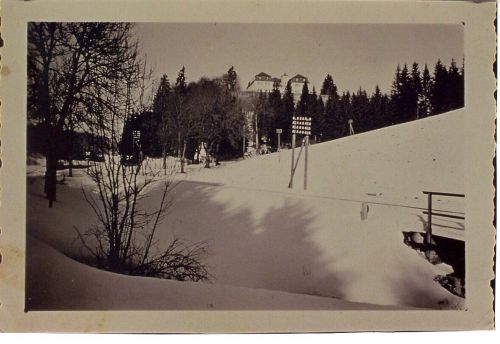Grafeneck

Grafeneck Castle 1940
Grafeneck Castle was built on a hill near Marbach in the Munsingen district between 1556 and 1560. In the years 1762 to 1772, Duke Karl Eugen converted the castle in a more contemporary style. During 1929, a Samaritan foundation in Stuttgart took over the building to serve as a hospice for invalids.
Early in October 1939, Dr. Herbert Linden of the Health Ministry visited Eugen Stahle, the official in the Wurttemburg Ministry of Interior responsible for health care, and asked for Stahle's co-operation in finding a relatively small institution 'to implement euthanasia.' Stahle proposed that Grafeneck could be used, and on October 14, 1939, Grafeneck Castle was appropriated. Between 10 to 15 manual labourers from nearby villages began to convert the castle into killing centres.
A short distance from the castle several barracks were built, fenced in with a hoarding up to 4 metres high. An additional 5 metres high screen hid the gas chamber and crematorium. On the first floor of the castle, amenities were installed which included accommodation and offices for doctors, a registry office, a police office, an office where the letters of condolence were written and various other departments. Quarters for the personnel were located on the second floor.
The main building of the killing facility was a barrack 68 ,metres long and 7 metres wide, which included several rooms. In one of them 100 beds were placed covered with straw mattresses. A wooden barrack served as the reception centre for arriving patients. Next to it an old coach house was converted into the gas chamber; it was disguised as a shower room complete with shower heads and wooden benches. Initially, the chamber had the capacity to gas 40-50 people at one time; later it was enlarged to hold 75 victims. A small room adjacent to the chamber contained the valves to activate the gassing process.
A small window permitted the physician to observe the gas chamber while he turned the valve. Three buses for the transportation of the victims and an ambulance car stood in a wooden garage. Two mobile oil-fuelled cremation ovens were located in another wooden barrack. Because of the immense heat generated by the round-the-clock cremations, the roof of the barrack was removed, and after a short time the surrounding trees were blackened from the noxious smoke and fumes emitted by the ovens. A former horse stable, probably served as a mortuary. At the bottom of the hill, at the access road, a hoarding and a guard house was built. Barbed-wire fences surrounded the whole castle, whilst armed guards, with dogs patrolled the perimeter, which had notices erected carrying the warning, 'Danger of Infection.'
In mid-November 1939, SS men, typists, and other personnel arrived and these were supplemented during early January 1940, with the arrival of approximately 25 male and female nurses, and in mid-January the cremation ovens were delivered. On January 18, 1940, the first transport of 25 handicapped males arrived from Eglfing- Haar near Munich, accompanied by the Grafeneck physician-in-chief Dr. Horst Schumann.
In the early summer of 1940, Dr. Schumann was ordered to the T4 Institute at Pirna-Sonnenstein, near Dresden. His successor at Grafeneck was Dr. Ernst Baumhardt, who was succeeded in turn by Dr. Gunther Hennecke. The chief administrator for a time was the infamous Christian Wirth, a detective superintendent of the Stuttgart Criminal Police. It was Wirth who supervised the first gassings at Grafeneck. Wirth later was to become the first commandant of the Belzec death camp in Poland, and then the Inspector of the Aktion Reinhardt SS-Sonderkommandos. A number of key personnel involved in Aktion Reinhardt, who served at Grafeneck included Rudolf Beckmann, Paul Bredow, Kurt Franz, Karl Frenzel, Willi Mentz, August Miete, Josef Oberhauser, Gottfried Schwarz, Heinrich Unverhau and others.
The killings continued until December 13, 1940. After this date Grafeneck was no longer part of the T4 Euthanasia programme, because it was considered that all the handicapped people who lived in the Grafeneck area had been killed. Some of the Grafeneck personnel went on holiday, whilst some others were ordered to the Hadamar T4 Institute. A few of the staff remained at Grafeneck Castle to cover up the traces of the murderous activities there.
Of the 80 -100 personnel who carried out the murders as part of the T4 Euthanasia programme in Grafeneck only eight were brought to trial, the others could not be traced. The eight were Otto Mauthe, Max Eyrich, Alfons Stegmann, Meta Fauser, Jakob Woger, Hermann Holzschul, Heinrich Unverhau and Maria Appinger. The trial was held at the Jury Court in Tubingen, from June 8, until July 5, 1949. At its conclusion three men were sentenced to terms in prison from 18 months to five years.
The number of people murdered at Grafeneck was 10,824. The Grafeneck memorial was officially opened in 1990.
Sources
Friedlander, Henry. The Origins of Nazi Genocide: From Euthanasia to the Final Solution, University of North Carolina Press, Chapel Hill, 1995.
Kogon, Eugen; Langbein, Hermann; Rückerl, Adalbert; eds. Nazi Mass Murder, Yale University Press, New Haven and London, 1993
Lifton, Robert Jay. The Nazi Doctors – Medical Killing and the Psychology of Genocide, Papermac, London, 1990.
www. Holocaustresearchproject.org - online resource
Photograph: Willi Mentz Album
© Holocaust Historical Society 2018

